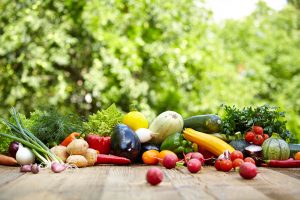By Angela C Torrence, ASU Nutrition Student
When I was a kid, broccoli and cauliflower were my enemies at the dinner table. I remember throwing my broccoli behind the radiator when no one was looking just so I wouldn’t have to endure another bite. This type of behavior may be all too familiar with you and your kids. If you are having a hard time getting your kids to eat their veggies, you are not alone. In fact, adults are missing the mark too! A study has recently been put out by the CDC which found that an alarming numbers of Americans just aren’t hitting their recommended fruits and vegetables intake with less than 14% of adults eating the recommended amount of fruits and less than 9% of adults eating the recommended amount of vegetables.

There are several things that might be contributing to these poor eating behaviors; namely the fact that we crave processed convenience foods, fat, sugar and salt. Including more fruits and vegetables might feel like a juggling act when life has so many other activities that we want to enjoy, but those types of foods have been shown to reduce the risk for many diseases including heart disease, diabetes, and some cancers.
Enjoying life now shouldn’t mean we sacrifice the health of our future. As adults, we have an obligation to the younger generations who look up to us to set an example in what we eat. It should be no surprise that most of our food choices are based off of how we were raised. But as they say, it takes a village to raise a child, and so with or without children of our own, we are all in a similar circumstance to be the example of how we should eat. If we don’t turn the tide of how to eat, future generations will follow in our footsteps and inherit all of the health problems that we have incurred.
The most updated Dietary Guidelines for Americans recommend adults have about 2 cups of fruit and 2.5 to 3 cups of vegetables daily. One of the ways I love to incorporate fruits and veggies into my diet is to simply add extra vegetables into the recipe. Let me give a few examples:
- Add carrots, mushrooms, or lima beans into a green bean casserole
- Add cooked peppers, spinach, and/or onions into Hamburger Helper-type meals
- Add sliced bananas or berries to cereal (tip: simply cut the banana with your spoon)
- Add cooked onion, peppers, garlic, mushrooms, and/or fresh basil to pasta sauce
- Add finely diced peppers, parsley, and scallions to burger patties
I have discovered that no meal should be void of either fruits or vegetables. Another way it is helpful to get servings of veggies is to use recipes which “hide” the veggies. This can be a great way get your kids to eat more vegetables too! Here are some recipes with hidden veggies:
- Red Beet Pancakes
- Black Bean Brownies
- Macaroni and cheese with butternut squash
- Veggies in Disguise Muffins
- Creamy Butternut Squash Linguini with Fried Sage
- Sweet Potato and Black Bean Veggie Burgers –Let the kids help with this one. When they help, they want to eat it!!
By incorporating more of the good stuff into your diet, you will have less room for the bad. Eating the recommended fruit and vegetable amounts shouldn’t mean you have to revamp your entire diet; just modify your meals and make them work for you instead!
About Angela C Torrence: 
Cooking is one of my passions that I love to share. Nutrition Communications major at Arizona State University and registered dental hygienist, I am motivated to help people reach optimal oral health and overall body health. Nutrition enthusiast and promoter of a plant-based diet, I bring the research to you, helping break the science down into bite-sized pieces.



